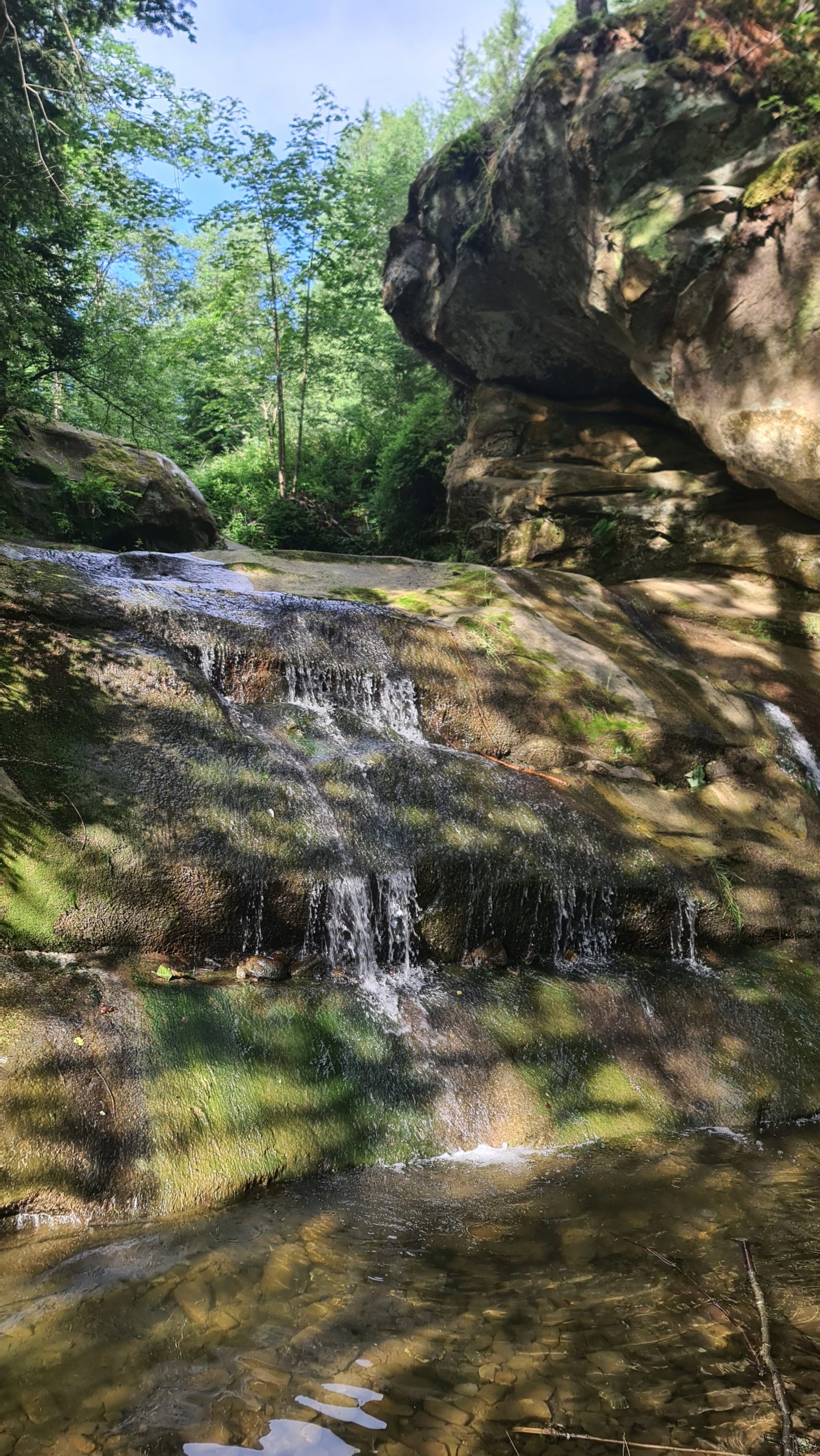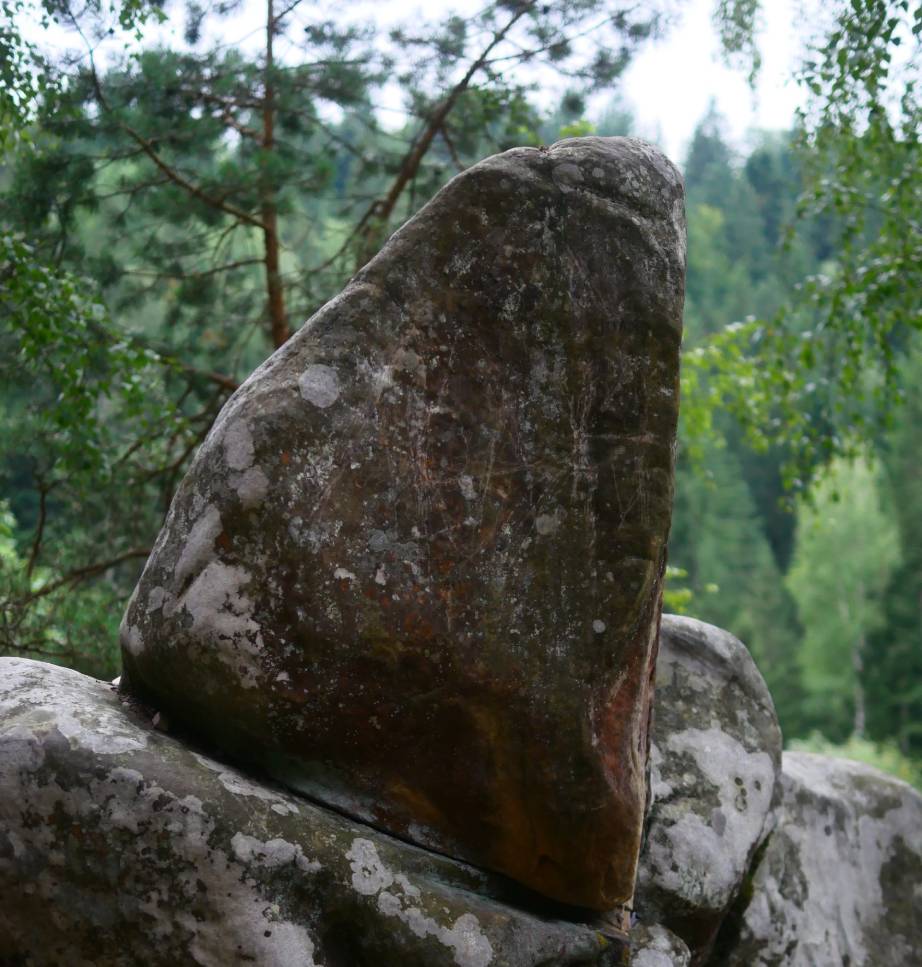Legends of Lada
We’ve gathered the most captivating legends about the Ternoshora Sanctuary so you can learn more about this sacred place.

Goddess Lada
The most famous megalith of the sanctuary is a 10-meter-tall anthropomorphic figure, associated with the Great Primordial Mother – the goddess Lada. She is depicted with broad feminine hips, a pregnant belly, milk-filled breasts, her right hand resting between chest and womb, a straight back, and a head with four faces gazing toward the four cardinal directions. The head rests on three supporting legs, with the neck serving as a pedestal that transitions into a square-shaped neck ornament. Slightly leaning back, the woman gazes toward the east.
Researchers believe that the figure’s posture and the shape of her belly indicate that this was an ancient astronomical observatory. As noted by scholar Lyubomyr Derzhypilsky in his book, the apex of the triangular belly and the head are aligned with the point of sunrise at the equinox, while the angle between the left and right planes of the belly encompasses the sector where the sun rises throughout the year. Thus, Lada – pregnant with the sun – seems to embrace the space where the sun is born.

The Solar Disc
At the foot of the Ternoshora Sanctuary lies a massive stone circle, 8 meters in diameter, made of two parts and shaped by human hands into a perfect ring – the symbol of the sun god. Upon closer inspection, the chips and grooves on its surface reveal the face of a lion: narrowed eyes, a broad nose, and even a discernible mane. In many cultures, the lion represents the supreme celestial body. This lion gazes southward, squinting as the bright sun shines into its eyes throughout the year – even in winter.
Above the solar disc is a small cave, symbolizing the feminine womb, and above that stands a stone figure of a pregnant woman. She looks toward the horizon where, each year in late December, the sun pauses. Her hand rests in the familiar gesture of expectant mothers – on her belly, just below the chest.
This story carved in stone tells the legend of how, each year, when the first stars of the constellation of Perun (Sagittarius) appear, the goddess Lada gives birth to the new Sun – Bozhych-Kolyada, the Sun of the Winter Solstice. Thus, Day (BiloBog) triumphs over Night (ChornoBog). From this point, the Sun begins its journey toward summer.

The Passage and the Chthonic Serpent
A narrow passage (about 50 cm wide) between two rocks is also part of the legend. At the exit of this rocky crevice lurks a serpent – a two-meter stone shaped like the head of a dragon-serpent, with an open mouth and a clearly defined left eye. Above this otherworldly creature looms a massive rock, scorched by fire.
According to researcher Professor Mykola Vasylovych Kugutyak, this passage is a vital element of the mythological system of the Ternoshorа Sanctuary. It is yet another legend carved in stone, telling how each day the god of the sky – the Sun – descends into the underworld, battles the serpent, and triumphs.
There is a belief that women enter the passage from the northern side, while men enter from the opposite direction. Here, in the shelter of ancient rocks, one can make a wish or create a personal ritual – for in such charged places, our thoughts and desires acquire extraordinary power. In mythology, passages symbolize transition: from the ordinary to the sacred, beyond the bounds of time and space – a gateway to change and profound transformation.

The Solar Gate
Through the triangular opening behind the statue of La a breathtaking view unfolds. This is the so-called Solar Gate – it visually frames the space where the sun sets beyond the horizon. The sunset at the equinox aligns perffectly with the center of the triangle, behind the peak of Mount Chornyi Hrun, above the Kagla hollow near the village of Snidavka.

The Nymphs’ Pool
On the way to Lada, beyond the Ternoshorа Huk waterfall, lies the so-called Nymphs’ Pool – a natural basin nestled among cozy grottoes, about 1.5 meters deep. According to legend, the cold water of the pool has healing and rejuvenating properties – no wonder the local nymphs choose it for their sacred baths.

The Phallic Stone
The phallic stone is an essential element of such sanctuaries – a symbol of fertility. Together with womb-shaped caves, it represents the union of masculine and feminine forces that bring new life into the world.
Lada was revered as the goddess of love, marriage, pregnancy, fertility, and women’s affairs. By touching the stone and making a wish, one can experience the power of ancient legends and rituals through which Lada is said to help women conceive.



